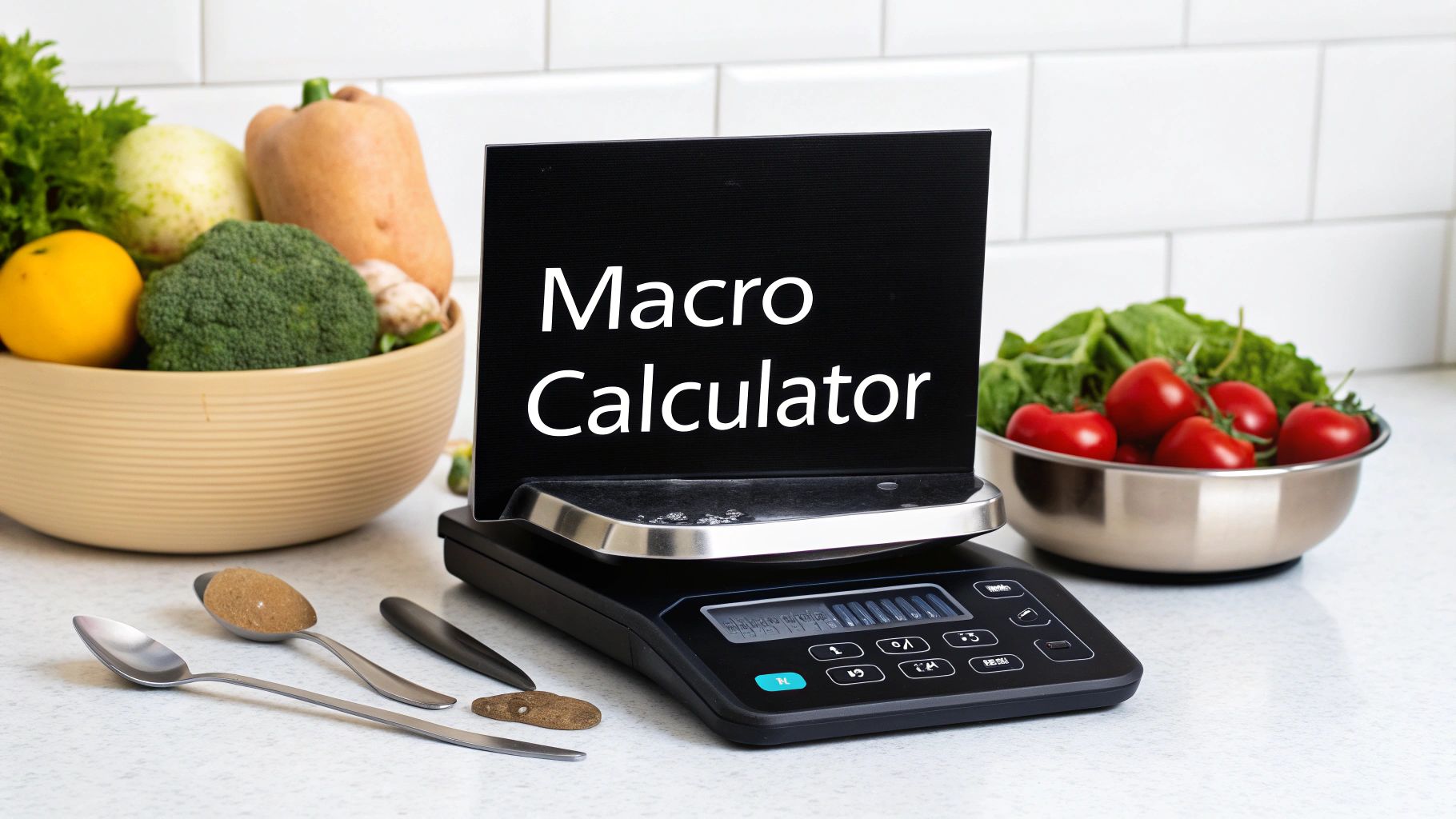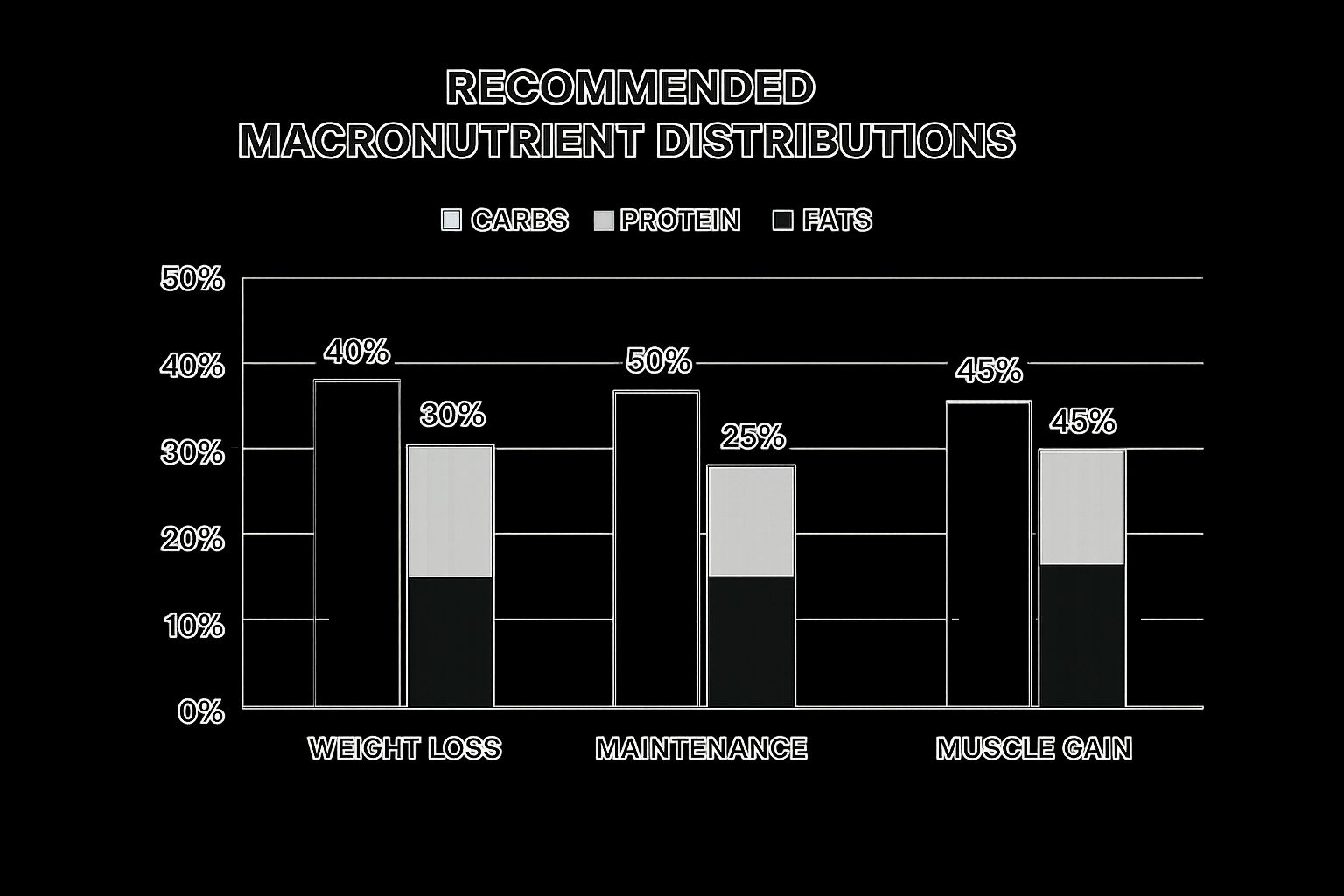Macro Calculator: Optimize Your Nutrition Effortlessly
Published on:
Macro Calculator: Optimize Your Nutrition Effortlessly
Understanding Macro Calculators: Beyond Simple Calorie Counting

Many people begin their nutrition journey by counting calories. However, this approach often misses a vital element: what makes up those calories. This is where macro calculators come in. They provide a more detailed and effective way to manage your diet.
Instead of just totaling calories, macro calculators focus on the balance of macronutrients: proteins, carbohydrates, and fats. This shift allows for a more personalized and effective approach to nutrition. You might be interested in How to master your macros with TrackEats.
Why Macronutrients Matter
Each macronutrient plays a unique role in your body. Protein builds and repairs tissues. Carbohydrates provide your primary energy source. Fats, while often misunderstood, are essential for hormone production and cell function.
A macro calculator helps determine the ideal balance of these nutrients based on your individual needs and goals. Someone looking to build muscle, for example, will likely need more protein than someone focused on weight loss. This personalized approach is a key benefit of using a macro calculator.
The Rise of Personalized Nutrition
Macro calculators are increasingly popular, reflecting a broader trend toward personalized health management. The diet and nutrition apps market, which includes macro calculators, was valued at approximately $11.8 billion in 2024.
This market is projected to reach $14.36 billion in 2025. This rapid growth highlights the increasing demand for tools that provide individual dietary guidance. These apps often embed macro calculators, providing users with valuable data to optimize their nutrition. More detailed statistics can be found here.
This move towards personalized nutrition is also pushing innovation in the development of more sophisticated and user-friendly macro calculators.
From Generic to Granular: The Evolution of Macro Calculators
Early macro calculators were often simple spreadsheets with basic calculations based on limited data. Today's calculators are far more advanced.
They consider factors such as your age, activity level, body composition goals (like weight loss or muscle gain), and even dietary preferences (vegetarian, vegan, etc.). This allows for highly personalized recommendations.
This level of detail empowers you to make informed food choices aligned with your health and fitness goals. It ensures you're not just eating enough, but eating the right foods in the right amounts to achieve your objectives.
The Science Behind Effective Macro Calculators
Behind every effective macro calculator lies a solid foundation of scientific principles. These tools use mathematical formulas to calculate key metrics, beginning with your Basal Metabolic Rate (BMR). Your BMR represents the minimum calories your body burns at rest to maintain basic functions.
From this baseline, calculators determine your Total Daily Energy Expenditure (TDEE) by considering your activity level. This provides a more practical estimate of your daily caloric needs.
Understanding The Algorithms
Advanced macro calculators go beyond simple BMR and TDEE calculations. They include variables like age, activity level, muscle mass, and fitness goals. For instance, a 25-year-old marathon runner will have different macro needs than a 50-year-old seeking moderate weight loss. This personalized approach ensures tailored recommendations.
However, different algorithms can produce varying results. This is why understanding the science behind the calculations is crucial.
To illustrate the various approaches and their effectiveness, let's look at a comparison of common formulas:
To help you choose the right calculator for your needs, let's compare some leading formulas:
Top Macro Calculator Formulas Compared
Comprehensive comparison of leading mathematical formulas used in modern macro calculators with their accuracy ratings and best applications
| Formula Name | Best For | Accuracy Rating | Limitations |
|---|---|---|---|
| Mifflin-St Jeor Equation | General population | High | May underestimate needs for very active individuals |
| Harris-Benedict Equation | Sedentary individuals | Moderate | Can overestimate needs for active individuals |
| Katch-McArdle Formula | Individuals with known body composition | Very High (requires body fat percentage) | Not practical for those without body fat measurement |
This table highlights the strengths and weaknesses of various formulas, emphasizing the importance of selecting a calculator that aligns with your individual characteristics and goals. Choosing the right formula is a key step in achieving accurate and effective macro tracking.
Evidence-Based Approaches Vs. Outdated Formulas
Some calculators rely on outdated formulas that may not accurately reflect individual needs. Prioritize calculators that use evidence-based approaches rooted in current research. Features like adaptive recalculations and wearable integration enhance the accuracy of modern tools. These advancements allow calculators to adjust your macro targets based on your real-time data. This leads to more precise and effective recommendations. This helps you choose calculators that deliver meaningful insights, not misleading numbers. Curious about your own numbers? Estimate your daily calories accurately with our Daily Calorie & Protein Estimator.
Macronutrient Distribution For Different Goals
The distribution of macronutrients—the percentage of calories from protein, carbohydrates, and fats—is another crucial aspect. This distribution varies depending on your goals. The following infographic illustrates recommended breakdowns for three common objectives:

As shown, individuals aiming for weight loss are often advised to consume more protein and fats. Those focused on muscle gain benefit from increased protein and carbohydrates. Maintaining weight typically involves a more balanced distribution. Understanding these variations helps you select the distribution best suited for your individual goals.
Selecting Your Perfect Macro Calculator Match
Finding the right macro calculator can significantly improve your fitness journey. Choosing the wrong one, however, can lead to months of frustration. Just like finding the perfect pair of shoes, the right fit is crucial for comfort and performance. This section will guide you through evaluating macro calculators based on your individual needs and objectives.
Free vs. Premium: Understanding the Trade-offs
Many free macro calculators offer basic functionality, calculating your macronutrient needs based on limited information. These calculators can be a good starting point, especially if you're new to macro tracking. However, they often lack the customization and advanced features found in premium options.
Premium macro calculators, while requiring an investment, often provide valuable features. These can include personalized recommendations, detailed progress tracking, and integration with other health apps like MyFitnessPal. Consider your budget and the level of detail you require when making your decision.
If you have specific dietary requirements or fitness goals, a premium calculator might be a worthwhile investment. The market for calculators, including macro calculators, shows strong growth potential. As of 2025, the global calculator market was valued at $447.18 million. It's projected to reach $635.935 million by 2033. This expansion reflects the increasing demand for specialized calculators across various sectors, including health. Find more detailed statistics here.
Goal-Oriented Calculators: Matching Your Objectives
Different macro calculators excel in different scenarios. Some are designed specifically for weight loss, emphasizing a caloric deficit and higher protein intake. Others cater to muscle building, recommending increased carbohydrates and protein to fuel growth. Still others are tailored for athletes, focusing on performance optimization and nutrient timing. Identifying your primary goal is the first step in narrowing down your choices.
Dietary Approaches and Calculator Compatibility
Your chosen dietary approach also plays a role in selecting a macro calculator. If you follow a ketogenic diet, you'll need a calculator that supports high-fat, low-carbohydrate intake. If you're vegan or vegetarian, you need a calculator that accounts for plant-based protein sources.
Intermittent fasting also requires specific considerations, as meal timing affects macro distribution. Some calculators are designed to accommodate these specific dietary needs.
To help you find the right fit, we've compiled a comparison of popular macro calculators:
Introducing our "Macro Calculator Showdown" table, designed to help you compare leading macro calculators side-by-side. We've highlighted key features, accuracy ratings, and ideal user profiles to simplify your decision-making process.
| Calculator | Best For | Key Features | Price | User Rating |
|---|---|---|---|---|
| Example Calculator 1 | Weight Loss | Calorie tracking, recipe logging, progress charts | Free/Premium | 4.5 stars |
| Example Calculator 2 | Muscle Gain | Macronutrient customization, workout tracking, supplement recommendations | Premium | 4.0 stars |
| Example Calculator 3 | Keto Diet | Net carb calculation, macro ratios, recipe database | Free | 4.2 stars |
| Example Calculator 4 | Vegan/Vegetarian | Plant-based protein tracking, micronutrient analysis, meal planning | Free/Premium | 4.7 stars |
This table provides a starting point for your research. Be sure to explore each calculator further to determine which one best aligns with your individual needs.
Testing and Evaluation: The Real-World Test
The true test of any macro calculator lies in its real-world application. Start by tracking your food intake and progress over a set period, such as two weeks. Compare your results to the calculator's predictions. Are you experiencing the expected changes in energy levels, body composition, or performance?
If not, you may need to adjust the calculator's recommendations or try a different calculator altogether. Consider resources like this guide on How to master food logging and progress tracking with TrackEats to improve your tracking accuracy.
Expert Insights: Strengths and Limitations
Learning from others' experiences can save you valuable time and effort. Research reviews and testimonials from nutrition professionals and experienced users. Pay attention to the strengths and weaknesses they highlight for different calculators.

This can give you valuable insights into which tool might best suit your specific circumstances. Remember, the "perfect" macro calculator is the one that helps you achieve your goals effectively and sustainably. Finding the right fit can make your nutrition journey more enjoyable and successful.
Transforming Calculator Results Into Daily Habits
A macro calculator can provide you with personalized targets. However, the real magic happens when you translate those numbers into everyday habits. This involves shifting your mindset. It's not just about knowing your macros, it's about weaving them into the fabric of your lifestyle. Think of your macro targets as a helpful guide, not strict rules set in stone.
Practical Strategies for Sustainable Macro Tracking
Integrating macros into your daily life involves several key strategies. Meal planning is paramount. Planning ahead helps you manage portions and align your meals with your macro goals.
Food selection is also essential. Choosing nutrient-rich foods allows you to meet your macro targets while nourishing your body with essential vitamins and minerals. For instance, prioritize lean proteins, complex carbohydrates, and healthy fats for optimal fuel.
Meal preparation plays a crucial role, too. Preparing meals or meal components in advance saves valuable time and minimizes the temptation of unhealthy choices when you're pressed for time.
Mastering Grocery Shopping, Batch Cooking, and Meal Timing
Strategic grocery shopping is a cornerstone of effective macro tracking. Create a shopping list based on your meal plan, concentrating on whole, unprocessed foods that fit within your macro targets. This helps avoid impulse buys and ensures you have the right ingredients available.
Batch cooking is a valuable time-saver, simplifying meal prep. Preparing larger portions of staples like grains, proteins, and vegetables on the weekend allows for quick and easy meal assembly during busy weeknights.
Strategic meal timing can further optimize your results. Distributing your macros throughout the day, in sync with your energy levels and exercise schedule, helps manage hunger and supports your fitness journey.
Navigating Common Challenges: Dining Out, Social Events, and Travel
Maintaining your macros doesn't require you to isolate yourself socially. When dining out, explore menu options that fit your targets. Don't hesitate to ask for modifications or substitutions to better suit your needs.
Social gatherings can sometimes pose a challenge. Focus on consuming protein and fiber-rich options to help curb hunger and cravings. Bringing a healthy dish to share is a great way to contribute while staying on track.
Travel can disrupt routines. Planning is key here, too. Pack healthy snacks or research restaurants at your destination that offer macro-friendly meals. Consider using resources like TrackEats to explore macro-friendly meal options.
Developing a Healthy Relationship with Food
While macro tracking can be a useful tool, nurturing a healthy relationship with food is crucial. Focus on overall nutrition and well-being, rather than solely fixating on numbers. Avoid obsessive tracking and embrace flexibility and balance for long-term success.
Adapting your approach to different life stages is also essential. Factors like pregnancy, aging, or changes in activity levels can influence your macro needs. Regularly reassess your goals and adjust your macro targets accordingly to ensure continuous progress and a healthy lifestyle.
Recipe Engineering With Macro Calculators
A macro calculator can be a valuable tool for understanding your nutritional needs. But how do you translate those numbers into meals you'll actually enjoy? That's where recipe engineering comes in. It's the art of creating dishes that not only satisfy your taste buds but also align with your macro targets. With a macro calculator, you can transform your cooking into a precise and enjoyable experience.
Deconstructing and Rebuilding Your Favorite Dishes
Many people worry that tracking macros means giving up their favorite foods. However, a little creativity can go a long way. You can adapt almost any recipe to fit your macro goals. Start by deconstructing your favorite dishes, breaking them down ingredient by ingredient. Then, using your macro calculator, rebuild the recipes by making smart substitutions and adjustments. You might also be interested in: How to master food logging and progress tracking with TrackEats.
Ingredient Substitution: Swapping for Success
Ingredient substitution is a cornerstone of recipe engineering. For example, if a recipe calls for heavy cream, you could use Greek yogurt or unsweetened almond milk to lower the fat content. This simple swap won't drastically change the texture or flavor. Similarly, swapping white rice for cauliflower rice or zucchini noodles can significantly reduce carbohydrate intake. Experimenting with different ingredients allows you to create macro-friendly versions of your favorite meals without sacrificing taste.
Portion Modification and Meal Combinations
Portion modification offers another way to adjust recipes. Sometimes, simply changing the serving size of an ingredient is all it takes. For example, if you're aiming for higher protein intake, you might increase the portion of chicken or fish in a stir-fry and reduce the amount of rice.
Strategic meal combinations can also be helpful. Pairing a protein-rich main dish with a fiber-rich side salad, for instance, can increase satiety and help you stay within your macro targets. This creates more flexibility and balance in your diet.

From Calculator Data to Culinary Delight: The Professional Approach
Professional nutritionists and chefs regularly use macro calculators for meal planning. They recognize the importance of balancing nutritional precision with culinary appeal. Using calculated data, they craft meal plans that not only meet specific macro requirements but also provide variety, flavor, and enjoyment. This professional approach proves that healthy eating doesn't have to be boring or restrictive. Speaking of the market, the recipe calorie calculator market is poised for significant growth. Valued at about USD 1.92 billion in 2024, projections indicate it will reach USD 3.2 billion by 2032. This represents a CAGR of approximately 6.57%. This growth is driven by increasing health awareness and concern over diet-related illnesses, prompting consumers to seek tools for precise dietary management. Learn more about the future of the recipe calorie market.
Building Your Personalized Recipe Database
As you experiment with recipe engineering, you'll create a personalized database of macro-friendly meals. This database becomes an invaluable resource for meal planning, making it easier and more enjoyable to adhere to your macros. It also allows you to develop signature dishes that impress friends and family while still meeting your nutritional goals. This personalized approach transforms macro tracking from a restrictive diet into a sustainable lifestyle change.
When Your Macro Calculator Misses The Mark
Even the most advanced macro calculator can sometimes fall short of delivering the expected results. While these tools provide a valuable starting point, they aren't perfect. Understanding how to identify and address discrepancies between your calculated macros and your body's response is essential for long-term success.
Identifying Discrepancies: Recognizing When Something's Off
One of the first signs that your macro calculations might be off is plateaued progress. If you've been consistently following your calculated macros, but your weight loss, muscle gain, or performance improvements have stalled, it might be time to reassess.
Another indicator can be unexpected energy fluctuations. Experiencing unusual fatigue or energy crashes despite adhering to your macros could signal a mismatch between your calculated needs and your body's actual requirements.
Hunger levels that don't align with your plan are another important clue. Constantly feeling hungry or, conversely, overly full despite eating your calculated macros is a sign that something needs adjusting.
Factors Beyond the Calculator: Understanding the Bigger Picture
Standard macro calculators often don't account for individual factors that can significantly influence your body's response to nutrition. Hormonal cycles, for example, can affect your metabolism and energy levels throughout the month.
Similarly, sleep quality plays a vital role in how your body processes nutrients. Poor sleep can disrupt hormone balance and lead to increased cravings, making it harder to adhere to your macro targets.
Stress levels also impact your body's nutritional needs. High stress can increase cortisol production, affecting your metabolism and appetite. Even medication can interfere with nutrient absorption or influence your body's energy expenditure.
Making Intelligent Adjustments: Fine-Tuning Your Approach
When your calculated macros aren't working, it's time for a systematic approach to troubleshooting. Start by keeping a detailed food journal, noting not only what you eat, but also how you feel after each meal. This provides valuable insights into how your body responds to different foods and macro ratios.
Next, consider making small incremental adjustments to your macros, rather than drastic changes. For example, if you're constantly hungry, try slightly increasing your protein or fiber intake. If you're experiencing energy crashes, experiment with adjusting your carbohydrate intake or timing.
If you're unsure how to proceed, consider seeking guidance from a registered dietitian or certified nutritionist. These professionals can provide personalized advice based on your individual needs and goals.
Knowing When to Seek Professional Guidance
While minor adjustments can often correct discrepancies, there are times when seeking professional guidance is crucial. If you have a medical condition or are taking medication that could be affecting your nutritional needs, consulting a healthcare provider is essential.
If you're struggling with disordered eating patterns or have a history of yo-yo dieting, working with a therapist or registered dietitian specializing in eating disorders is important. These professionals can provide support and guidance in developing a healthy relationship with food.
Start optimizing your nutrition with TrackEats! Discover how TrackEats can help you simplify macro tracking and achieve your health and fitness goals.